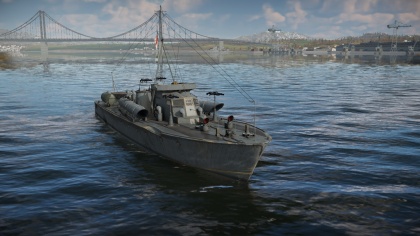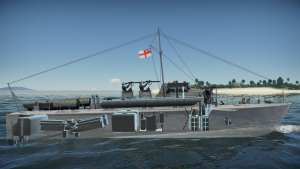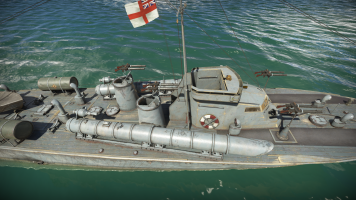Difference between revisions of "MTB Vosper"
m (Grammar) |
(Surivability, Mobility, Pros and cons, History additions; minor grammar and wording changes in some other places) |
||
| Line 20: | Line 20: | ||
[[File:X-RayImage StarboardView Vosper1.png|thumb|Vosper 1 series internals (starboard side). Note the ammo storages below the bridge.]] | [[File:X-RayImage StarboardView Vosper1.png|thumb|Vosper 1 series internals (starboard side). Note the ammo storages below the bridge.]] | ||
| − | Any gun in the game will easily be able to penetrate anywhere on the boat at practically any range. Vosper 1 series can | + | Any gun in the game will easily be able to penetrate anywhere on the boat at practically any range. |
| + | |||
| + | Vosper 1 series can be hull-broken by any gun that is greater than or equal to 4 inches (102 mm) in diameter. Hull-break triggers when a capable gun destroys any hull compartment or the bridge, resulting in instant destruction of the rest of the boat. At Vosper 1 series' battle rating, these include the [[8cwt QF Mk I (114 mm)|8cwt QF Mk I]] (found on {{Specs-Link|uk_dark_class}}), the [[4 in QF Mark V (102 mm)|4 in QF Mark V]] (found on {{Specs-Link|uk_isles_class_trawler}}), and the [[BL Mark IX (102 mm)|BL Mark IX]] (found on {{Specs-Link|uk_flower_class}}). While it isn't uncommon for a boat in tier 1 and 2 to be able to be hull-broken by guns larger than 4 inches, it's relatively rare for it to be able to be hull-broken by actual 4-inch guns. This trait is generally given only to reserve boats or boats very early in the tech tree, including Vosper 1 series. | ||
Vosper 1 series' hull is split into three compartments. The first compartment starts at the bow and ends just in front of the forward gun mounts. The second starts at the forward gun mounts and ends in front of the engines. The third starts at the engines and ends at the stern. Overall, with a crew complement of 10, survivability is average. | Vosper 1 series' hull is split into three compartments. The first compartment starts at the bow and ends just in front of the forward gun mounts. The second starts at the forward gun mounts and ends in front of the engines. The third starts at the engines and ends at the stern. Overall, with a crew complement of 10, survivability is average. | ||
| Line 52: | Line 54: | ||
|- | |- | ||
|} | |} | ||
| + | |||
| + | When moving forwards at high speeds, the bow will slightly lift out of the water, and the hull will drift very slightly to starboard without any player input, though both are unnoticeable in gameplay and don't affect the firing of the guns in any real way. Vosper 1 series has a displacement of 38 tons. | ||
== Armament == | == Armament == | ||
| Line 208: | Line 212: | ||
The boats built following MTB 102 all shared its design, although the hull was lengthened to 70 feet. In 1940, with the entrance of Italy into WWII, engines from Isotta Fraschini could no longer be obtained and subsequent boats had to be fitted with much weaker petrol engines (1,800 bhp total) from American manufacturer Hall Scott as a stopgap measure until they could be upgraded with more powerful petrol engines from Packard, though this wasn't until 1941. In total, 28 of the 32 planned 70 ft Vosper MTBs were completed: | The boats built following MTB 102 all shared its design, although the hull was lengthened to 70 feet. In 1940, with the entrance of Italy into WWII, engines from Isotta Fraschini could no longer be obtained and subsequent boats had to be fitted with much weaker petrol engines (1,800 bhp total) from American manufacturer Hall Scott as a stopgap measure until they could be upgraded with more powerful petrol engines from Packard, though this wasn't until 1941. In total, 28 of the 32 planned 70 ft Vosper MTBs were completed: | ||
| − | * MTBs 20-23: Ordered 15th August 1938, all completed by December 1939. MTBs 20, 21, and 23 were sent to the Romanian Navy. MTB 22 | + | * MTBs 20-23: Ordered 15th August 1938, all completed by December 1939. MTBs 20, 21, and 23 were sent to the Romanian Navy. MTB 22 served with the 4th MTB Flotilla and survived to the end of the war. |
| − | * MTBs 29-30: Ordered on 8th September 1938, all completed by July 1940. Both | + | * MTBs 29-30: Ordered on 8th September 1938, all completed by July 1940. Both served with the 4th MTB Flotilla. MTB 29 was lost in a collision with a German E-boat on 6th October 1942, and MTB 30 struck a mine and was lost on 18th December 1942. |
* MTBs 31-40: Ordered on 27th September 1939, 6 completed by May 1941. MTBs 33, 37, 39, and 40 were bombed by German aircraft before completion between 1940 and 1941. The completed boats survived to the end of the war. | * MTBs 31-40: Ordered on 27th September 1939, 6 completed by May 1941. MTBs 33, 37, 39, and 40 were bombed by German aircraft before completion between 1940 and 1941. The completed boats survived to the end of the war. | ||
| Line 218: | Line 222: | ||
* MTBs 69-70: Ordered in April 1940, both completed by June 1940. Both only received two engines. Both served with HMS Beehive at Felixstowe and survived to the end of the war. | * MTBs 69-70: Ordered in April 1940, both completed by June 1940. Both only received two engines. Both served with HMS Beehive at Felixstowe and survived to the end of the war. | ||
| − | * MTBs 218-221: Ordered on 7th December 1940, all completed by September 1941. MTBs 218 struck a mine on 18th August 1942, and MTB 220 was sunk by German E-boats on 13th May 1942. MTBs 219 and 221 survived to the end of the war. MTB 221 was sold in 1945. | + | * MTBs 218-221: Ordered on 7th December 1940, all completed by September 1941. MTBs 218 struck a mine and was lost on 18th August 1942, and MTB 220 was sunk by German E-boats on 13th May 1942. MTBs 219 and 221 survived to the end of the war. MTB 221 was sold in 1945. MTB 219 was transferred to the Sea Cadet Corps at Staines in 1945 and was converted to a houseboat in 1948. |
Modifications to the original 70 ft Vosper MTB design would lead to the development of the 72 ft Vosper MTB and 73 ft Vosper MTB. | Modifications to the original 70 ft Vosper MTB design would lead to the development of the 72 ft Vosper MTB and 73 ft Vosper MTB. | ||
Revision as of 06:37, 5 May 2020
Contents
Description
The MTB Vosper 1 series is a rank British motor torpedo boat
with a battle rating of (AB), (RB), and (SB). It was introduced in Update 1.83 "Masters of the Sea" as part of the British fleet closed beta test.
General info
Survivability and armour
Vosper 1 series has the following armour layout:
- Hull: 24 mm, wood
- Superstructure: 15 mm, wood
Any gun in the game will easily be able to penetrate anywhere on the boat at practically any range.
Vosper 1 series can be hull-broken by any gun that is greater than or equal to 4 inches (102 mm) in diameter. Hull-break triggers when a capable gun destroys any hull compartment or the bridge, resulting in instant destruction of the rest of the boat. At Vosper 1 series' battle rating, these include the 8cwt QF Mk I (found on Dark Adventurer), the 4 in QF Mark V (found on HMS Liscomb), and the BL Mark IX (found on HMCS Brantford). While it isn't uncommon for a boat in tier 1 and 2 to be able to be hull-broken by guns larger than 4 inches, it's relatively rare for it to be able to be hull-broken by actual 4-inch guns. This trait is generally given only to reserve boats or boats very early in the tech tree, including Vosper 1 series.
Vosper 1 series' hull is split into three compartments. The first compartment starts at the bow and ends just in front of the forward gun mounts. The second starts at the forward gun mounts and ends in front of the engines. The third starts at the engines and ends at the stern. Overall, with a crew complement of 10, survivability is average.
Of note are the ammo storages located just underneath the bridge. Destroying these will also destroy the rest of the boat. In practice, though, this almost never happens, since most guns at this battle rating are either machine guns or low-calibre autocannons which require a large number of hits to destroy the ammo storages. It's both faster and easier to just target the hull compartments and knock out the crew.
Mobility
| Mobility Characteristics | |||||
|---|---|---|---|---|---|
| Game Mode | Upgrade Status | Maximum Speed (km/h) | Turn Time (s) | Turn Radius (m) | |
| Forward | Reverse | ||||
| AB | Stock | 76 | 27 | ~19.43 | ~37.80 |
| Upgraded | 105 | 37 | ~12.61 | ~22.86 | |
| RB/SB | Stock | 64 | 22 | ~21.92 | ~43.61 |
| Upgraded | 74 | 26 | ~17.84 | ~34.70 | |
When moving forwards at high speeds, the bow will slightly lift out of the water, and the hull will drift very slightly to starboard without any player input, though both are unnoticeable in gameplay and don't affect the firing of the guns in any real way. Vosper 1 series has a displacement of 38 tons.
Armament
Primary armament
In her main armament group, Vosper 1 series has four twin 7.72 mm Lewis machinegun 1916 mounts, two on each wing in front of the bridge and two staggered behind the bridge, for a total of 8 guns. For each mount, there are 1,940 rounds of ammunition available, 970 rounds per gun, for a total of 7,760 rounds. All of the mounts traverse horizontally at a rate of 75°/s and vertically at a rate of 75°/s. Each gun has a magazine capacity of 97 rounds and has a rate of fire of 550 rounds/min. With a stock crew, the guns can be reloaded in 10.4 seconds; with an aced crew, they can be reloaded in 8 seconds. Their maximum range against surface targets is roughly 1.6 km.
| Turrets are named sequentially, clockwise, starting at the bow |
| Guidance for the Main Gun Turrets | |||||||
|---|---|---|---|---|---|---|---|
| No.1 Turret (front-right) | No.2 Turret (back-right) | No.1 Turret (back-left) | No.2 Turret (front-left) | ||||
| Horizontal | Vertical | Horizontal | Vertical | Horizontal | Vertical | Horizontal | Vertical |
| ±180° | -7°/+70° | ±180° | -10°/+70° | ±180° | -10°/+70° | ±180° | -7°/+70° |
There are three choices of ammunition available:
- Universal: AP/T/AP/T
- 7.7 mm AP belt: AP/AP/AP/T
- 7.7 mm API belt: IT/IT/IT/AP
| Penetration Statistics | ||||||
|---|---|---|---|---|---|---|
| Ammunition | Penetration @ 0° Angle of Attack (mm) | |||||
| 10 m | 100 m | 500 m | 1,000 m | 1,500 m | 2,000 m | |
| Universal | 20 | 19 | 16 | 13 | 11 | 10 |
| 7.7 mm AP belt | 20 | 19 | 16 | 13 | 11 | 10 |
| 7.7 mm API belt | 20 | 19 | 16 | 13 | 11 | 10 |
Torpedo armament
Vosper 1 series has two torpedo tubes, one on each side, and can carry two 533 mm Mk.VIII torpedoes. The torpedo tubes are pointed forwards, but they are angled outwards on each side and are fixed, requiring the boat to be turned in order to aim them.
| Torpedo Characteristics | ||||||||
|---|---|---|---|---|---|---|---|---|
| Torpedo Mode | Mass (kg) | Maximum speed in water (km/h) | Travel distance (km) | Depth stroke (m) | Arming distance (m) | Explosive type | Explosive mass (kg) | TNT equivalent (kg) |
| No | 1566 | 84 | 4.57 | 1 | 50 | TNT | 327 | 327 |
| Yes | 1566 | 76 | 6.40 | 1 | 50 | TNT | 327 | 327 |
The Torpedo Mode modification is available as a tier IV modification. Installing it has the following changes:
| Torpedo Mode Specification Changes | |
|---|---|
| Max Distance (m) | Max Speed (m/s) |
| +1830 | -1 |
Usage in battles
Like MTB-1(1) that comes directly before it on the tech tree, Vosper 1 series' main armament consists only of low-calibre machine guns, although this is somewhat alleviated by the fact that she has eight such guns. Still, the guns are limited by their low maximum range of 1.6 km. Unlike MTB-1 1 series though, Vosper 1 series can only bring all eight guns to target in very small ~7.5° arc about 60° to port (i.e. roughly the 10 o'clock position). In general, though, only four or six of the eight guns will ever be on target at the same time. Even so, six guns are enough to destroy most targets at this tier without needing to reload. With only four of eight guns though, the guns will have to be reloaded at least once in order to destroy most targets, so engagements either directly in front of or directly behind the boat, where only two of the gun mounts can be brought to bear, are undesirable.
With a magazine size of 97 rounds per gun and a rate of fire of 550 rpm, the guns can fire for 10.58 seconds, very good compared to most other machine guns at this tier, though not the best. Compared to the quadruple mounts on MTB-1 1 series, the twin mounts on Vosper 1 series can be reloaded much quicker, between 8 and 10.4 seconds depending on the crew, which also puts it above the reload of the twin AN-M2 (12.7 mm) mounts that many tier 1 US boats have. Nevertheless, this reload is still quite long. Because of this, it's always better to empty the magazines after each engagement so that the maximum amount of ammunition is available for the next engagement.
- Ammunition Choices
The best ammunition choice is the 7.7 mm AP belt since it has the highest ratio of AP to T rounds. While the 7.7 mm API belt may look tempting because of the incendiary tracer rounds, the IT rounds are actually stopped by most wooden hulls and rarely start fires, if ever. This belt is the best to use against aircraft, though with such a long reload to switch to it and such a minuscule difference in damage, there isn't much of a point in using it for that role either.
- Torpedoes
The Mk.VIII torpedoes are a decent torpedo with above-average top speeds and warhead size. Its maximum range is more of less average compared to other torpedoes at this tier.
The Torpedo Mode modification should never be installed. The higher maximum speed is much more valuable against the fast-moving boats of tier I and II, and the 4.57 km maximum range with the Torpedo Mode modification installed is more than enough for the small maps.
Be aware though that, if the torpedo is unused, it can be shot at, and, if it's destroyed, there is a chance the entire boat can be destroyed along with it. For this reason, it's best to either use them early on or to not take them into battle at all.
Modules
| Tier | Seakeeping | Unsinkability | Firepower | |||
|---|---|---|---|---|---|---|
| I | Dry-Docking | Tool Set | 7.7 mm AP belt | |||
| II | Rudder Replacement | Fire Protection System | Smokescreen | 7.7 mm API belt | ||
| III | Propeller Replacement | Primary Armament Targeting | ||||
| IV | Engine Maintenance | New Pumps | Artillery Support | Torpedo Mode | ||
Pros and cons
Pros:
- Good manoeuvrability
- Large number of guns
- Decent reload
- Good torpedoes, above-average maximum speed and TNT equivalence
Cons:
- Main armament consists of low-calibre machine guns, low damage output per gun
- Main armament has a small maximum range, ~1.6 km
- Not all gun mounts can be on target at once, one or more of the mounts will be blocked at most angles
History
During the 1930s, the Admiralty tried to reestablish the coastal boat flotillas it once possessed during the first World War. British boatbuilding company Vosper & Company vied for the contract but lost both times in 1935 and 1936, the contract to build the first coastal boats since WWI going instead to the British Power Boat Company. Vospers continued in their effort to receive a contract from the Admiralty for their boats but to no avail. At the time, though, the Admiralty had unofficially suggested that future contracts would only be awarded for boats that were able to reach 40 knots and that were armed with two 21-inch torpedoes as well as light anti-aircraft guns. With these specifications, Vospers took the risk and preemptively began development on a new motor torpedo boat.
In 1937, Vospers completed their prototype. It was 69.5 feet long and had a hard chine hull design, like many boats at the time, which produced hydrodynamic lift at high speeds, lifting the hull out of the water to reduce drag. It was powered by three petrol engines from Italian manufacturer Isotta Fraschini, each driving a single shaft, together producing 3,600 bhp. The prototype displaced 33 tons, and, in internal trials, it reached 43.7 knots loaded and 47.8 knots unloaded. For its torpedo armament, many different arrangements were tried, but it was eventually decided that they should be mounted on either side of the bridge, pointed forwards and angled outwards. This torpedo placement was uncommon at the time but would become the standard placement on Allied motor torpedo boats during WWII. For its gun armament, Vospers experimented with various combinations of 0.303 calibre machine guns, 0.50 calibre machine guns, and a 20 mm autocannon. The prototype went on trials for the Admiralty in 1938, after which it was purchased and designated MTB 102. In 1939, MTB 102 went on trials against a competing design by British Power Boat Co. Vospers won, and, subsequently, its design was selected to be the newest line of Coastal Forces motor torpedo boats.
The boats built following MTB 102 all shared its design, although the hull was lengthened to 70 feet. In 1940, with the entrance of Italy into WWII, engines from Isotta Fraschini could no longer be obtained and subsequent boats had to be fitted with much weaker petrol engines (1,800 bhp total) from American manufacturer Hall Scott as a stopgap measure until they could be upgraded with more powerful petrol engines from Packard, though this wasn't until 1941. In total, 28 of the 32 planned 70 ft Vosper MTBs were completed:
- MTBs 20-23: Ordered 15th August 1938, all completed by December 1939. MTBs 20, 21, and 23 were sent to the Romanian Navy. MTB 22 served with the 4th MTB Flotilla and survived to the end of the war.
- MTBs 29-30: Ordered on 8th September 1938, all completed by July 1940. Both served with the 4th MTB Flotilla. MTB 29 was lost in a collision with a German E-boat on 6th October 1942, and MTB 30 struck a mine and was lost on 18th December 1942.
- MTBs 31-40: Ordered on 27th September 1939, 6 completed by May 1941. MTBs 33, 37, 39, and 40 were bombed by German aircraft before completion between 1940 and 1941. The completed boats survived to the end of the war.
- MTBs 57-66: Ordered on 26th February 1940, all completed by April 1942. MTB 61 was stranded during an attack on 9th May 1943, and MTBs 63 and 64 were lost after collisions with friendly MTBs on 2nd April 1943. The remaining boats were sold in 1944.
- MTBs 69-70: Ordered in April 1940, both completed by June 1940. Both only received two engines. Both served with HMS Beehive at Felixstowe and survived to the end of the war.
- MTBs 218-221: Ordered on 7th December 1940, all completed by September 1941. MTBs 218 struck a mine and was lost on 18th August 1942, and MTB 220 was sunk by German E-boats on 13th May 1942. MTBs 219 and 221 survived to the end of the war. MTB 221 was sold in 1945. MTB 219 was transferred to the Sea Cadet Corps at Staines in 1945 and was converted to a houseboat in 1948.
Modifications to the original 70 ft Vosper MTB design would lead to the development of the 72 ft Vosper MTB and 73 ft Vosper MTB.
Media
See also
External links
- ww2ships.com - 70' Vosper Motor Torpedo Boat
- unithistories.com - Royal Navy Coastal Forces 1940-1945
- naval-history.net - British vessels lost at sea in World War 2 - MGB, MTB, SGB, ML, etc - originally published in British Vessels Lost at Sea, 1935-45, His Majesty's Stationary Office, 1947
- harwichanddovercourt.co.uk - Torpedo Boats - World War 2
- uboat.net - Vosper 70 feet-type class
| Britain boats | |
|---|---|
| Motor torpedo boats | Brave Borderer · Dark Aggressor · Dark Aggressor TD · Fairmile D (617) · Fairmile D (697) · Fairmile D (5001) · HMS Gay Archer |
| MTB-1(1) · MTB-1(2) · MTB Vosper · MTB Vosper(2) · MTB-422 | |
| Motor gun boats | Dark Adventurer · Fairmile A (ML100) · Fairmile B (ML345) · Fairmile C (312) · Fairmile C (332) · Fairmile D (601) · Fairmile H LCS(L)(2) |
| HMAS Arrow · HMAS Fremantle · MGB-61 · MGB-75 · ML 1383 · SGB Grey Fox · SGB Grey Goose | |
| Gunboats | HMS Spey |








